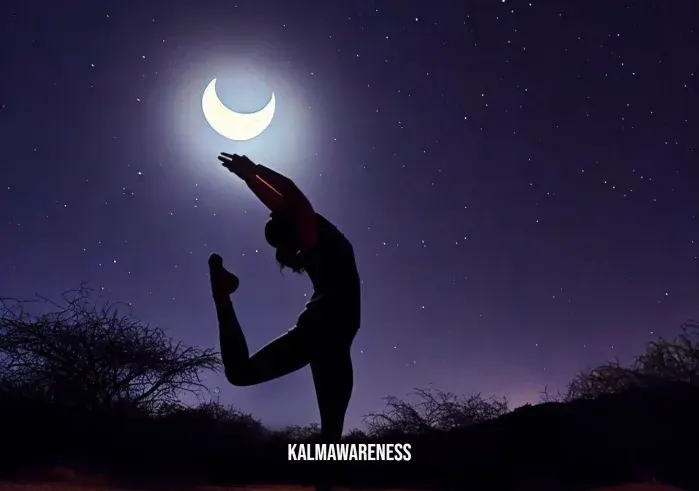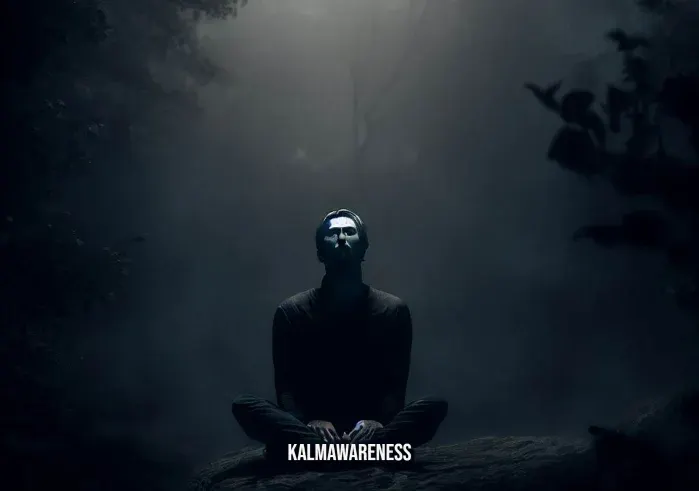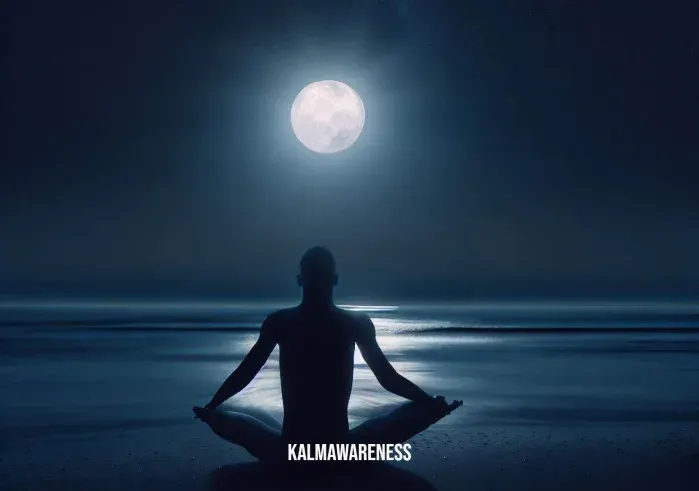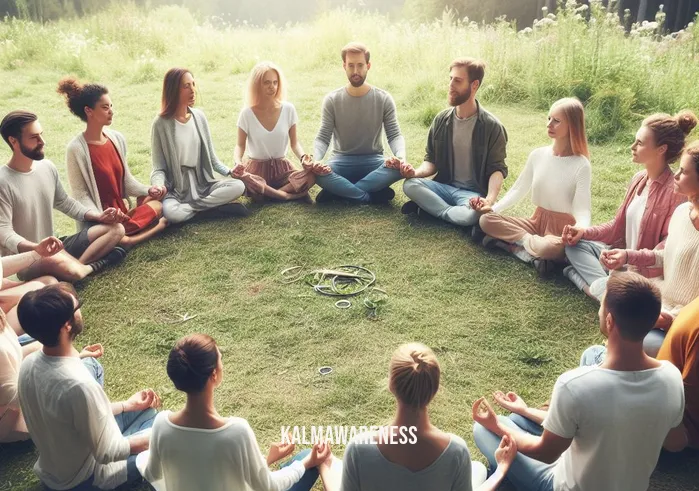Yoga Pose: Moon Pose Yoga
In this article, we will explore the graceful and calming Moon Pose Yoga, also known as “Chandra Namaskar” in Sanskrit. This yoga pose is part of our Yoga cluster and falls under the category of Gentle Yoga Poses on our website. Let’s dive into the description and explanation of this beautiful pose.
| Description | Explanation |
|---|---|
| Pose Name | Moon Pose Yoga |
| Original Name | Chandra Namaskar |
| Difficulty Level | Beginner to Intermediate |
| Pose Category | Gentle Yoga Poses |
| Exercise Duration | Approximately 1-2 minutes |
Duration:
- For Beginners: Hold the pose for about 1 minute, gradually increasing the duration with practice.
- For Advanced Practitioners: Aim for holding the pose for up to 2 minutes, focusing on maintaining steady breath and alignment.
Step-by-Step Guide:
- Starting Position: Begin in a standing position at the top of your mat. Stand tall with your feet together and your arms by your sides. Take a few deep breaths to center yourself.
- Mountain Pose (Tadasana): Inhale deeply as you extend your arms overhead, palms facing each other. Interlace your fingers and release your index fingers, pointing them up. Stretch your whole body upwards, lengthening your spine.
- Side Bend: As you exhale, gently lean to the right side, elongating your left side body. Hold the stretch for a few seconds, feeling the opening along your left ribcage. Inhale back to the center.
- Side Bend – Left: Exhale as you bend to the left side, creating a beautiful arch on the right side of your body. Keep both feet grounded and shoulders relaxed. Inhale back to the center.
- Half Moon Pose (Ardha Chandrasana): Step your left foot back about 3-4 feet and turn it slightly outward. Inhale, lift your left arm towards the sky, and reach your right hand towards the front of the mat. Extend your torso forward as you bring your left leg parallel to the floor. Engage your core for stability.
- Goddess Pose: From Half Moon Pose, gracefully transition into Goddess Pose by opening your hips to the left side and bending both knees. Your feet should be wider than your hips, and your toes turned slightly outward. Bring your arms out to the sides, creating a “T” shape with your body.
- Reverse Warrior (Viparita Virabhadrasana): Inhale as you straighten your right leg, and pivot your left foot slightly inward. Reach your right arm up towards the sky and lean back, creating a gentle arch along your right side. Your left hand can rest lightly on your left thigh.
- Extended Side Angle Pose (Utthita Parsvakonasana): Bend your right knee, keeping it aligned with your right ankle. Exhale and lower your right forearm onto your right thigh, extending your left arm over your head. Keep your chest open and gaze towards your left fingertips.
- Triangle Pose (Trikonasana): From Extended Side Angle Pose, straighten your right leg and lift your torso, reaching both arms out in a straight line. Hinge at your right hip and place your right hand on your shin, ankle, or the floor. Extend your left arm towards the sky, creating a straight line from your left hand to your left foot.
- Goddess Pose – Second Side: Come back to Goddess Pose, facing the opposite side. Bend your knees and open your arms wide.

Yoga Pose: Moon Pose Yoga
Welcome to the second part of our exploration into the serene Moon Pose Yoga, where we’ll delve into the numerous benefits this pose offers, modifications for different experience levels, and important considerations for those who should avoid practicing this pose.
Benefits of Moon Pose Yoga:
- Stress Relief: Moon Pose Yoga promotes relaxation and reduces stress by calming the mind and encouraging mindful breathing. The flowing movements help release tension from the body, leaving you feeling more at ease.
- Flexibility: This yoga sequence involves stretching and opening various muscle groups, including the hips, hamstrings, and shoulders. With regular practice, you can improve flexibility and range of motion.
- Balance and Coordination: As you transition through different postures, Moon Pose Yoga enhances your balance and coordination. It challenges you to find stability in each position, improving overall body awareness.
- Digestive Health: The twisting movements in Moon Pose Yoga gently massage the abdominal organs, supporting digestion and aiding in the elimination of waste.
- Emotional Healing: The fluid and graceful movements of this sequence encourage emotional release and introspection, providing a nurturing space to process feelings and experiences.
- Energy Flow: Moon Pose Yoga helps to balance the flow of energy throughout the body, fostering a sense of harmony and vitality.
Variations of Moon Pose Yoga for Different Levels:
- Beginner Variation: If you’re new to yoga or still developing your practice, it’s essential to focus on alignment and stability. Modify the pose by using yoga blocks under your hands during poses like Triangle Pose to maintain balance and prevent strain.
- Intermediate Variation: As you become more comfortable with the sequence, you can deepen the stretches and explore longer holds in each pose. Experiment with extending your reach in Reverse Warrior and Triangle Pose to enhance the opening in your side body.
- Advanced Variation: For seasoned practitioners, challenge yourself by incorporating more challenging transitions and adding a bind in poses like Extended Side Angle or Triangle Pose. You can also try lifting your top leg in Half Moon Pose for an added balancing challenge.
Who Should Avoid Moon Pose Yoga:
While Moon Pose Yoga is generally accessible to many practitioners, certain individuals should avoid or modify the practice:
- Pregnant Women: Moon Pose Yoga involves deep stretches and balance poses that may not be suitable for pregnant women. It’s best to consult a qualified prenatal yoga instructor for appropriate modifications.
- Injury or Chronic Conditions: If you have any existing injuries or chronic health conditions, especially in the hips, knees, or shoulders, it’s crucial to approach this sequence with caution. Seek guidance from a yoga teacher or healthcare professional to tailor the practice to your needs.
- High Blood Pressure: Some of the movements in Moon Pose Yoga may cause fluctuations in blood pressure. If you have high blood pressure or hypertension, avoid forward bends and consult your doctor before attempting this sequence.
- Vertigo or Dizziness: If you experience vertigo or dizziness, it’s best to avoid the more complex balance poses and opt for gentle grounding practices instead.
Who Cannot Do Moon Pose Yoga:
Moon Pose Yoga is generally safe for most individuals, but there are specific cases where it is not recommended:
- Recent Surgeries: If you’ve had any recent surgeries, especially in the hips, legs, or spine, it’s essential to avoid this sequence until you’re fully healed and cleared by your healthcare provider.
- Chronic Pain: If you experience chronic pain that worsens with movement or specific yoga poses, it’s best to consult a healthcare professional before attempting Moon Pose Yoga.
- Severe Joint Issues: Individuals with severe joint issues, such as advanced arthritis or joint degeneration, should approach this practice with caution and seek personalized modifications.
Now that we’ve explored the benefits, variations, and considerations for practicing Moon Pose Yoga, you’re ready to step onto your mat and embrace the serenity of this beautiful sequence. Remember, always listen to your body and modify the practice as needed to ensure a safe and enjoyable experience.

Yoga Pose: Moon Pose Yoga
In this final part of our exploration into Moon Pose Yoga, we will delve into its intriguing history, its spiritual significance, tips for maximizing the benefits of the pose, common mistakes to avoid, modifications for practitioners with injuries or limited flexibility, and poses that complement the Moon Pose Yoga sequence.
The History of Moon Pose Yoga:
Moon Pose Yoga, or Chandra Namaskar, has its roots in ancient Indian yogic practices. It is a variation of the more well-known Sun Salutation (Surya Namaskar) and is traditionally practiced to honor and connect with the moon’s soothing and feminine energy. In yogic philosophy, the moon represents the receptive and introspective aspects of our being, making this sequence an ideal practice for fostering inner peace and emotional balance.
The Spiritual Significance of Moon Pose Yoga:
Beyond the physical benefits, Moon Pose Yoga holds deep spiritual significance. Each movement within the sequence is infused with intention and symbolism, allowing practitioners to tap into the following aspects:
- Emotional Release: Moon Pose Yoga encourages the release of pent-up emotions and nurtures self-compassion. As you flow through the poses, it’s an opportunity to acknowledge and honor your emotional landscape.
- Feminine Energy: The moon has long been associated with feminine energy, representing intuition, nurturing, and creativity. This yoga sequence helps practitioners embrace and embody these qualities.
- Cycles of Renewal: Just as the moon waxes and wanes, Moon Pose Yoga reflects the cyclical nature of life. It serves as a reminder to honor life’s ever-changing rhythms and find balance in both light and darkness.
Tips for Getting the Most out of Moon Pose Yoga:
- Practice in the Evening: To align with the moon’s energy, consider practicing Moon Pose Yoga in the evening or during the full moon. It can enhance the calming and introspective effects of the sequence.
- Mindful Breathing: Pay attention to your breath throughout the practice. Let your breath guide your movements and maintain a steady, deep breath to create a sense of calm.
- Connect with Nature: If possible, practice Moon Pose Yoga outdoors, under the moonlit sky or in a quiet space surrounded by nature. Connect with the elements and allow them to enhance your practice.
Common Mistakes to Avoid:
- Rushing Through Transitions: Moon Pose Yoga is about embracing fluidity and grace. Avoid rushing through the poses and focus on maintaining a smooth and controlled transition from one posture to another.
- Overexertion: Listen to your body and avoid pushing yourself too hard, especially if you’re new to the sequence. It’s essential to find your edge without straining or forcing the poses.
Modifications for People with Injuries or Limited Flexibility:
- Knee Issues: If you have knee concerns, place a folded blanket or cushion under your knee during poses like Low Lunge and Extended Side Angle to cushion the joint.
- Limited Flexibility: For those with limited flexibility, use props like blocks or a chair to support your practice. For instance, use blocks under your hands in Triangle Pose to bring the floor closer to you.
Poses that Complement Moon Pose Yoga:
- Child’s Pose (Balasana): After practicing Moon Pose Yoga, relax into Child’s Pose to release any residual tension and foster a sense of surrender.
- Seated Forward Bend (Paschimottanasana): This pose complements Moon Pose Yoga by gently stretching the hamstrings and promoting relaxation.





